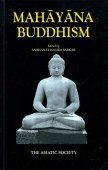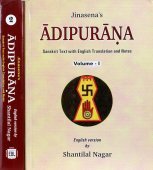Prakrit, Prakṝt: 6 definitions
Introduction:
Prakrit means something in Hinduism, Sanskrit, the history of ancient India. If you want to know the exact meaning, history, etymology or English translation of this term then check out the descriptions on this page. Add your comment or reference to a book if you want to contribute to this summary article.
The Sanskrit term Prakṝt can be transliterated into English as Prakrt or Prakrit, using the IAST transliteration scheme (?).
In Hinduism
Natyashastra (theatrics and dramaturgy)
Source: archive.org: Natya ShastraPrakrit.—In connexion with the dramatic representation, it (the Prakrit recitation) is of three kinds, viz,
- that with the same words as in Sanskrit (samāna-śabda),
- that with corrupt (vibhraṣṭa) words,
- that with words of indigenous origin (deśī).

Natyashastra (नाट्यशास्त्र, nāṭyaśāstra) refers to both the ancient Indian tradition (shastra) of performing arts, (natya—theatrics, drama, dance, music), as well as the name of a Sanskrit work dealing with these subjects. It also teaches the rules for composing Dramatic plays (nataka), construction and performance of Theater, and Poetic works (kavya).
India history and geography
Source: Cologne Digital Sanskrit Dictionaries: Indian Epigraphical GlossaryPrakrit.—Anglicised spelling of Prākṛta, the name of a language. Note: prakrit is defined in the “Indian epigraphical glossary” as it can be found on ancient inscriptions commonly written in Sanskrit, Prakrit or Dravidian languages.
Source: Singhi Jain Series: Ratnaprabha-suri’s Kuvalayamala-katha (history)Prakrit refers to one of the four major languages prevalent in ancient India, according to the 8th-century Kuvalayamālā written by Uddyotanasūri, a Prakrit Campū (similar to Kāvya poetry) narrating the love-story between Prince Candrāpīḍa and the Apsaras Kādambarī.—There is a mention of four major languages, namely, Sanskrit, Prakrit, Apabhramsha and Paishachi; and during the 8th century, vast body of Apabhramsha literature appears to have been already produced. The Paishachi language seems to have been represented by the Bṛhatkathā which had survived in its original form upto the time of Uddyotanasūri. This appears to be very probable since the original Paiśācī Bṛhatkathā was known to Kṣemendra who based his Sanskrit version on it.

The history of India traces the identification of countries, villages, towns and other regions of India, as well as mythology, zoology, royal dynasties, rulers, tribes, local festivities and traditions and regional languages. Ancient India enjoyed religious freedom and encourages the path of Dharma, a concept common to Buddhism, Hinduism, and Jainism.
Languages of India and abroad
Sanskrit dictionary
Source: DDSA: The practical Sanskrit-English dictionaryPrakṝt (प्रकॄत्).—1 U.
1) To announce, proclaim, mention.
2) To name, call.
3) To praise, extol, laud.
Source: Cologne Digital Sanskrit Dictionaries: Cappeller Sanskrit-English DictionaryPrakṛt (प्रकृत्).—cut off or asunder.
Prakṛt is a Sanskrit compound consisting of the terms pra and kṛt (कृत्).
Source: Cologne Digital Sanskrit Dictionaries: Monier-Williams Sanskrit-English Dictionary1) Prakṛt (प्रकृत्):—[=pra-kṛt] -√2. kṛt [Parasmaipada] -kṛntati, ([Epic] also -kartati), to cut off;
—to cut up, cut to pieces, [Atharva-veda; Mahābhārata]
2) Prakṝt (प्रकॄत्):—[=pra-√kṝt] See pra-√kīrt.
Sanskrit, also spelled संस्कृतम् (saṃskṛtam), is an ancient language of India commonly seen as the grandmother of the Indo-European language family (even English!). Closely allied with Prakrit and Pali, Sanskrit is more exhaustive in both grammar and terms and has the most extensive collection of literature in the world, greatly surpassing its sister-languages Greek and Latin.
See also (Relevant definitions)
Starts with (+143): Prakrita, Prakrita Drishti, Prakrita-siddhantavada, Prakritabhashakavya, Prakritabhashantaravidhana, Prakritabhashin, Prakritacandrika, Prakritacchandahkosha, Prakritacchandahsutra, Prakritacchandattika, Prakritachandahkosha, Prakritachandahsutra, Prakritachandattika, Prakritadhvani, Prakritadhyaya, Prakritadipika, Prakritajvara, Prakritaka, Prakritakalpataru, Prakritakamadhenu.
Ends with: Khasprakrit, Viprakrit.
Full-text (+45411): Accha, Java, Jaya, Kaccha, Kana, Kattha, Gahaṇa, Majja, Pautta, Ukkosa, Pakkhoda, Aha, Joa, Joana, Desia, Caya, Pariaddhaa, Auttiya, Nia, Jagara.
Relevant text
Search found 69 books and stories containing Prakrit, Prakṝt, Prakṛt, Pra-krit, Pra-kṛt, Prakrt, Pra-krt, Pra-kṝt; (plurals include: Prakrits, Prakṝts, Prakṛts, krits, kṛts, Prakrts, krts, kṝts). You can also click to the full overview containing English textual excerpts. Below are direct links for the most relevant articles:
Bhagavati-sutra (Viyaha-pannatti) (by K. C. Lalwani)
Reviews < [August 1937]
Linguistic and Cultural Studies of < [January 1968]
The Beginnings of Oriya < [April 1939]
Natyashastra (English) (by Bharata-muni)
Chapter XVIII - Rules on the use of Languages (bhāṣā)
Part 5 - More Data of India’s Cultural History in the Nāṭyaśāstra < [Introduction, Part 2]
Jainism and Patanjali Yoga (Comparative Study) (by Deepak bagadia)
The three Silavratas < [Chapter 3 - Jain Philosophy and Practice]
Part 5.1 - The main Twelve Angas < [Chapter 3 - Jain Philosophy and Practice]
Part 4 - Stages of spiritual elevation (guna-sthanakas) < [Chapter 3 - Jain Philosophy and Practice]
Dasarupaka (critical study) (by Anuru Ranjan Mishra)
Summary of the Nāṭyaśāstra < [Introduction]
Part 1 - Mahendravarman—Author of the drama (Mattavilāsa-Prahasana) < [Chapter 3 - Prahasana (critical study)]
Part 14 - Other features of the Dūtavākya < [Chapter 5 - Vyāyoga (critical study)]
Vasudevavijaya of Vasudeva (Study) (by Sajitha. A)
Śrīcihnakāvya of Kṛṣṇalīlāśuka and Durgāprasādayati < [Chapter 1 - Śāstrakāvyas—A Brief Survey]
Dvyāśrayakāvya / Kumārapālacarita of Hemacandra < [Chapter 1 - Śāstrakāvyas—A Brief Survey]
Comprehensiveness in illustration of Paninian rules < [Chapter 4 - Vāsudevavijaya—A Literary Appreciation]
Related products





